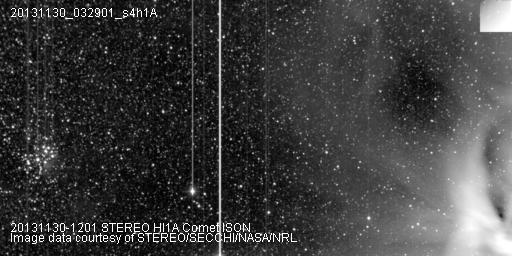W&T Wetenschap & Technologie
Een plek om te discussiėren over wetenschappelijke onderwerpen, wetenschappelijke problemen, technologische projecten en grootse uitvindingen.



<a href="http://www.vwkweb.nl/" rel="nofollow" target="_blank">[b]Vereniging voor weerkunde en klimatologie[/b]</a>
<a href="http://www.estofex.org/" rel="nofollow" target="_blank">[b]ESTOFEX[/b]</a>
<a href="http://www.estofex.org/" rel="nofollow" target="_blank">[b]ESTOFEX[/b]</a>


<a href="http://www.vwkweb.nl/" rel="nofollow" target="_blank">[b]Vereniging voor weerkunde en klimatologie[/b]</a>
<a href="http://www.estofex.org/" rel="nofollow" target="_blank">[b]ESTOFEX[/b]</a>
<a href="http://www.estofex.org/" rel="nofollow" target="_blank">[b]ESTOFEX[/b]</a>


THE GHOST OF COMET ISON:
Yesterday, Dec. 6th, leading researchers from the Comet ISON Observing Campaign (CIOC) held an informal workshop at the Johns Hopkins Applied Physics Lab. One of the key questions they discussed was, Did Comet ISON survive? It might seem surprising that anyone is still asking. After all, the "comet" that emerged from the sun's atmosphere on Thanksgiving day appeared to be little more than a disintegrating cloud of dust. This movie from the STEREO-A spacecraft (processed by Alan Watson) shows the V-shaped cloud fading into invisibility on Dec. 1st:
The answer hinges on the contents of that cloud. Is it nothing more than a cloud of dust--or could there be some some fragments of the disintegrated nucleus still intact and potentially active?
A key result announced at the workshop comes from SOHO, the Solar and Heliospheric Observatory. According to the spacecraft's SWAN instrument, the comet stopped producing so-called Lyman alpha photons soon after its closest approach to the sun. Karl Battams of the CIOC explains what this means: "Without getting technical, Lyman-Alpha is a consequence of sunlight interacting with hydrogen, and if we are not seeing that interaction then it means that the levels of hydrogen (and hence ice) are extremely low. This is indicative of a completely burned out nucleus, or no nucleus at all."
"The evidence appears strong that at some point approaching perihelion - whether days or hours - Comet ISON likely began to completely fall apart," he continues. "What remains of ISON now is going to be either just a cloud of dust, or perhaps a few very depleted chunks of nucleus. Either way, it's not going to flare up at this point and we should assume the comet's show is over."
"However, we do need to verify this," says Battams. "Hopefully the Hubble team can come to the rescue! In mid-December, Hubble will be pointed in the direction of where ISON should be and they'll try and image something. If no fragments are surviving, or they are tiny, then Hubble will not be able to find anything, but that negative detection will tell us something: namely that ISON is indeed gone for good."
Yesterday, Dec. 6th, leading researchers from the Comet ISON Observing Campaign (CIOC) held an informal workshop at the Johns Hopkins Applied Physics Lab. One of the key questions they discussed was, Did Comet ISON survive? It might seem surprising that anyone is still asking. After all, the "comet" that emerged from the sun's atmosphere on Thanksgiving day appeared to be little more than a disintegrating cloud of dust. This movie from the STEREO-A spacecraft (processed by Alan Watson) shows the V-shaped cloud fading into invisibility on Dec. 1st:
The answer hinges on the contents of that cloud. Is it nothing more than a cloud of dust--or could there be some some fragments of the disintegrated nucleus still intact and potentially active?
A key result announced at the workshop comes from SOHO, the Solar and Heliospheric Observatory. According to the spacecraft's SWAN instrument, the comet stopped producing so-called Lyman alpha photons soon after its closest approach to the sun. Karl Battams of the CIOC explains what this means: "Without getting technical, Lyman-Alpha is a consequence of sunlight interacting with hydrogen, and if we are not seeing that interaction then it means that the levels of hydrogen (and hence ice) are extremely low. This is indicative of a completely burned out nucleus, or no nucleus at all."
"The evidence appears strong that at some point approaching perihelion - whether days or hours - Comet ISON likely began to completely fall apart," he continues. "What remains of ISON now is going to be either just a cloud of dust, or perhaps a few very depleted chunks of nucleus. Either way, it's not going to flare up at this point and we should assume the comet's show is over."
"However, we do need to verify this," says Battams. "Hopefully the Hubble team can come to the rescue! In mid-December, Hubble will be pointed in the direction of where ISON should be and they'll try and image something. If no fragments are surviving, or they are tiny, then Hubble will not be able to find anything, but that negative detection will tell us something: namely that ISON is indeed gone for good."
<a href="http://www.vwkweb.nl/" rel="nofollow" target="_blank">[b]Vereniging voor weerkunde en klimatologie[/b]</a>
<a href="http://www.estofex.org/" rel="nofollow" target="_blank">[b]ESTOFEX[/b]</a>
<a href="http://www.estofex.org/" rel="nofollow" target="_blank">[b]ESTOFEX[/b]</a>


Lees net:
http://modernsurvivalblog(...)ire-in-january-2014/
Zou ISON dan de "oorzaak" kunnen zijn van die meteoor die van de week boven Nederland is gespot?
http://modernsurvivalblog(...)ire-in-january-2014/
Zou ISON dan de "oorzaak" kunnen zijn van die meteoor die van de week boven Nederland is gespot?


Als je het betreffende topic hier leest, kom je al een heel eindquote:Op woensdag 22 januari 2014 13:33 schreef Frutsel het volgende:
Lees net:
http://modernsurvivalblog(...)ire-in-january-2014/
Zou ISON dan de "oorzaak" kunnen zijn van die meteoor die van de week boven Nederland is gespot?
|
|




